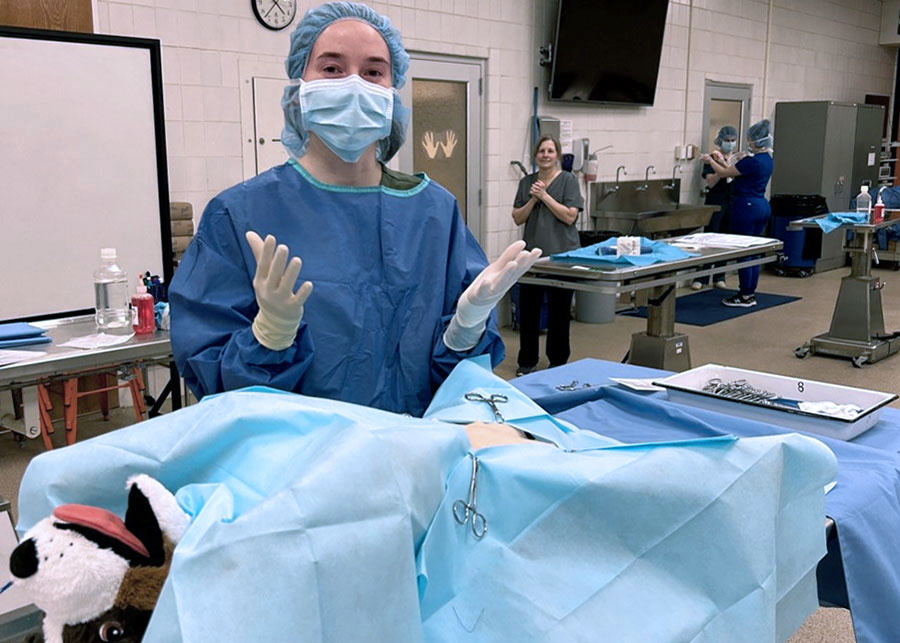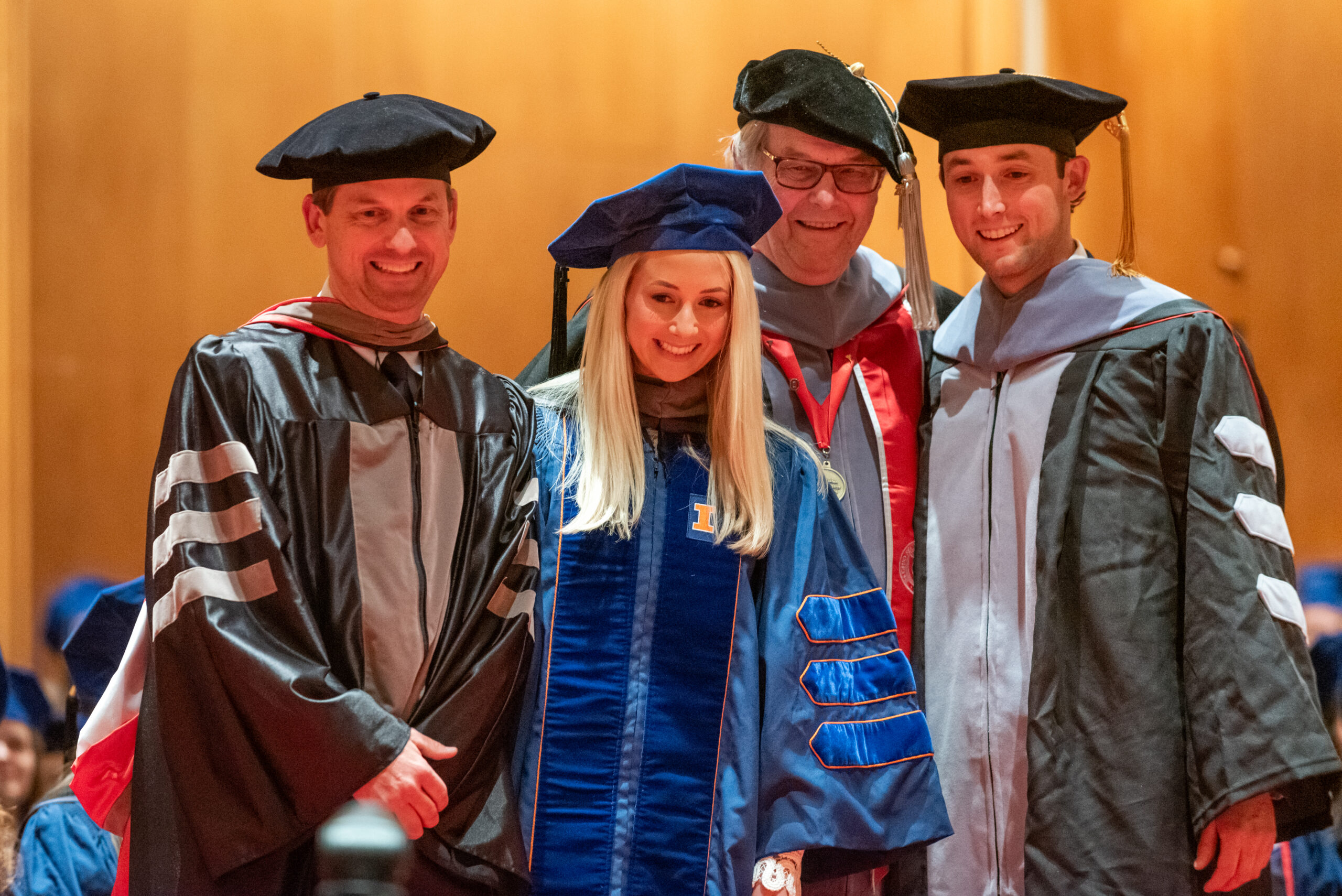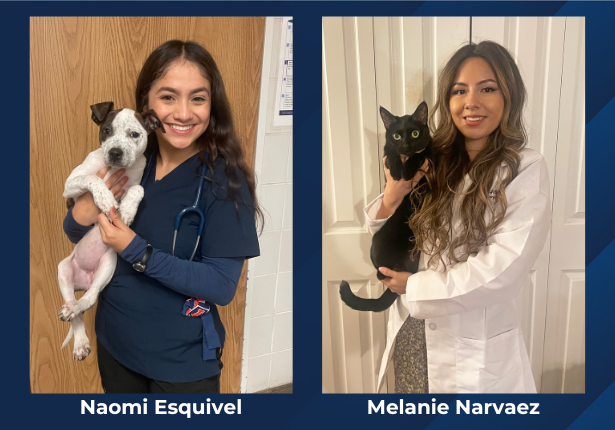Koalas and echidnas and bats, oh my!
Over spring break this year, five Illinois veterinary students and instructor Dr. Sarah Reich, medical director of the college’s Wildlife Medical Clinic, visited the Currumbin Wildlife Sanctuary in Queensland, Australia. They participated in many activities in its wildlife hospital. Following are highlights from the students about their week and some of the amazing animals they learned about.
Taylor Willis, Class of 2020: Tawny Frogmouths
If it has ever crossed your mind to travel to Australia, you should go immediately. Buy yourself a plane ticket, book a stay at a nice Airbnb or beach resort perhaps, and then go to the Currumbin Wildlife Sanctuary to gain some hands-on experience at their wildlife hospital.
![[Taylor Willis holds a snake]](https://vetmed.illinois.edu/wp-content/uploads/2021/04/sb-willis-snake.jpg) At least, that’s what I did anyway! Four other Illinois veterinary students and I took a one-week trip to Currumbin and had one unforgettable adventure.
At least, that’s what I did anyway! Four other Illinois veterinary students and I took a one-week trip to Currumbin and had one unforgettable adventure.
Since everyone who went on the trip aspires to be a zoo or wildlife veterinarian after graduation, our trip was heavily tailored to get the most zoo and wildlife experience we possibly could. From the very beginning we hit the ground running. We were given a tour, introduced to the head veterinarian and the rest of the staff, and immediately had a case involving an injured koala.
Gliders and carpet pythons and flying foxes, oh my! There was no shortage of Australian wildlife seen during my week abroad. My all-time favorite patients of the week were the tawny frogmouths. (That’s Podargus strigoides, for all the nerds like me in the back.)
These majestic birds are native throughout the Australian mainland and Tasmania. They are big-headed and stocky, have a cryptic coloration that resembles that of tree bark, and have an abnormally wide mouth, comparable to that of a frog. In my opinion, the frog-like mouth is one of the craziest parts to see on the tawny frogmouths.![[inside the mouth of a tawny frogmouth bird]](https://vetmed.illinois.edu/wp-content/uploads/2021/04/sb-australia-frogmouth.jpg)
The biggest threats to tawny frogmouths are human related; they are often hit by cars and are sometimes caught in a battle with domestic dogs and cats. These reasons are precisely why we had multiple opportunities to work with them in the Currumbin Wildlife Hospital. From fractures, scratches, dehydration, to you name it, the injuries we encountered gave us first-hand experience. We also got to compare and contrast how procedures are handled in Australia versus at the Wildlife Medical Clinic here at the University of Illinois.
The skills and experiences I gained during that week are ones I will cherish for the rest of my veterinary career. I had the opportunity to watch and participate in surgical procedures on species that I had never seen before, work with some amazing Australian veterinarians and staff, and gain more confidence in my abilities just before entering my clinical-year rotations. I had the opportunity to be immersed in a different culture and observe a “day in the life of a zoo/wildlife veterinarian” within the Currumbin.![[koala]](https://vetmed.illinois.edu/wp-content/uploads/2021/04/sb-australia-koala.jpg)
Although the visit lasted only one week, I somehow made connections and lifelong friendships in a field that desperately requires networking. If you are willing to learn from the cases that you do see, see wildlife that you may never get the opportunity to work with again, practice or learn new skills, and travel across the world to learn about international veterinary medicine, then I would say this trip is definitely for you.
Sara Colin, Class of 2022: Bats
Bats are often perceived as scary, blood-thirsty creatures, an image perpetuated through vampire lore and Halloween traditions. Despite their bad reputation, bats play an important role in their ecosystems: they aid in pollination, seed dispersion, and pest (mosquito) control.
Bats are also evolutionarily unique. They are the only mammal with full flight capabilities. They range in size, diet, and habitat and can be found on every continent except Antarctica.
Bats are generally characterized into either microbats or mega bats. As the terms imply, the two types are distinctly different in size. North America is home to various species of micro-bats, including families Vespertilionidae, Molossidae, Mormoopidae, and Phyllostomidae of the order Chiroptera. Australia, however, has more than 75 species of bats, including both mega bat species (including flying foxes) and microbat species.
Flying foxes, my personal favorite during the trip, could be spotted nightly flying across the sky and vocalizing in trees.
![[Sara Colin poses in front of a mural of a bat]](https://vetmed.illinois.edu/wp-content/uploads/2021/04/sb-colin-bat-mural.jpg)
Captive bats at the sanctuary and those in rehabilitation settings are housed together in “roosts” because of their inherently social nature. Although social groups are necessary, housing bats in groups occasionally results in problems when the bats are sorting out hierarchies or mating.
A few of the flying foxes that were admitted to the clinic were females with abscesses on the back of their necks. These abscesses are caused during mating season when the males become hormonally aggressive and attempt to restrain females for copulation by biting the scruff area on the dorsal side of the females. Many of these injuries heal, but some become infected and progress to abscesses that need medical intervention.
![[kangaroo]](https://vetmed.illinois.edu/wp-content/uploads/2021/04/sb-australia-kangaroo.jpg) While this mating behavior is normal, the resulting wounds are more likely to be observed—and therefore treated—in captive roosts than in wild roosting populations. At the sanctuary, I was able to watch the wound assessment and cleaning and the administration of antibiotics and analgesia. If these abscesses were not treated, the infection could cause septicemia or impede the ability of flight – both likely fatal.
While this mating behavior is normal, the resulting wounds are more likely to be observed—and therefore treated—in captive roosts than in wild roosting populations. At the sanctuary, I was able to watch the wound assessment and cleaning and the administration of antibiotics and analgesia. If these abscesses were not treated, the infection could cause septicemia or impede the ability of flight – both likely fatal.
Wounds are not limited to bat-on-bat aggression. A more common, year-round issue for both mega and microbats are collisions with barbed wire. In only one week at the clinic, I saw several cases of barbed wire injuries, ranging from minor to fatal. All of these injuries compromised the bats’ flight capability, which made them identifiable as injured by the pubic and animal control.
The wings of these bats had holes and rips of various sizes. Small holes eventually heal and form a scar on the wing; animals with this type of injury are kept in rehabilitation settings until they heal. However, rips on the edge of the caudal wing membrane could result in scarring that would shorten the extension of the wing and result in permanent flight deficits. Ultimately, these animals would not be able to survive in the wild. Therefore, bats with severe injuries were deemed non-releasable and humanely euthanized.
These preventable injuries are not limited to Australian wildlife. At the Wildlife Medical Clinic at Illinois, barbed-wire injuries were present in eight animals admitted since 2014; all of these animals died or were humanely euthanized. These preventable injuries and deaths emphasize the need for human modification when it comes to fence security. It is critical that we share this knowledge and make more educated, wildlife-cognizant choices to prevent injuries like these in the future.
John Winter, Class of 2020: Echidna
The Currumbin Wildlife Sanctuary hosts a research breeding population of one of the most bizarre-looking and mysterious creatures on earth: the short-beaked echidna (Tachyglossus aculeatus). Currently at the sanctuary there are over 25 echidnas in breeding pairs, whose secretive habits and reproductive behaviors are being studied. The sanctuary holds the world record for most echidnas bred in captivity at 19 puggles (the admittedly adorable name for echidna young). Working with the University of Queensland, the project hopes one day to use this breeding information to help save the endangered long-beaked echidna (Zaglossus spp.) found in Papua New Guinea.
![[John Winter with parrots]](https://vetmed.illinois.edu/wp-content/uploads/2021/04/sb-winter-parrots.jpg) Both within the order Monotremata, echidnas and the platypus are the only two mammals in the world that lay eggs. But this unique trait is only one of a number of bizarre adaptions of echidnas that we learned about at the Currumbin Wildlife Hospital. For research and education purposes, we were able to observe a post-mortem examination of an echidna that was euthanized at the hospital because its injuries were too severe to treat.
Both within the order Monotremata, echidnas and the platypus are the only two mammals in the world that lay eggs. But this unique trait is only one of a number of bizarre adaptions of echidnas that we learned about at the Currumbin Wildlife Hospital. For research and education purposes, we were able to observe a post-mortem examination of an echidna that was euthanized at the hospital because its injuries were too severe to treat.
Tragically, many wild animals brought to the wildlife clinic arrive with injuries or sickness so severe the humane decision is to euthanize. We assisted with euthanasia on several animals during our visit, including many bird species.
During the post-mortem of the echidna, we were able to see the unique reproductive anatomy of the echidna, which includes a penis with four glans (heads) called rosettes. We were also able to see how small the thorax was and how long the tongue was, which they use to eat insects.
After mating, the female echidna lays an egg into her pouch, where the egg remains until it hatches. Once hatched, the newborn echidna nurses inside the mother’s pouch, like koalas, kangaroos, and many other marsupials. This examination of the echidna was a sad but very educational experience in which we were able to see anatomy vastly different from that of the dogs and horses we study in veterinary school!
Our Australian trip was truly a once-in-a-lifetime experience. We were able to see preventive medicine, diagnosis, and treatment of zoo and wildlife animals that we would never see outside of zoos in the United States! It was fantastic being able to compare the diseases and anatomy of these Australian animals to what we are familiar with in our American species. We also went on guided tours of the sanctuary with Dr. Andrew and learned how habitats and species interactions within those enclosures are planned to promote the health of these captive animals.
Our group had a fantastic time living among the Aussies for a week, and I can’t wait to go back “Down Under” someday!
Kirsten Andersson, Class of 2021: Koala
I’m a second-year veterinary student interested in zoo and exotic veterinary medicine. I was thrilled to have the opportunity to head back to Australia for a week to shadow at the Currumbin Wildlife Hospital.
As an undergrad, I studied abroad at the University of Queensland for a semester. At that time, I did not have many opportunities to work closely with the wildlife, but I did enjoy admiring them from afar. I will never forget the first time I saw a koala in the wild, and because of that, they were one of the animals I was the most excited about having the opportunity to work with.
![[Kirsten Andersson holds a koala]](https://vetmed.illinois.edu/wp-content/uploads/2021/04/sb-andersson-koala.jpg) To my surprise, a koala was the very first animal I encountered in the clinic. I ended up getting to see a few different koala cases throughout the week, but my favorite one was a female koala that came in with a severe cystitis evident by copious amounts of discharge near her cloaca. She was in very poor health, with a low body condition score and low PCV and TP levels. The veterinarians ended up electing to euthanize, and we did a post-mortem examination the following day.
To my surprise, a koala was the very first animal I encountered in the clinic. I ended up getting to see a few different koala cases throughout the week, but my favorite one was a female koala that came in with a severe cystitis evident by copious amounts of discharge near her cloaca. She was in very poor health, with a low body condition score and low PCV and TP levels. The veterinarians ended up electing to euthanize, and we did a post-mortem examination the following day.
What we found absolutely blew my mind!
The most unbelievable characteristic of the koala on necropsy was the size of her cecum. Koalas rely entirely on eucalyptus leaves, which are not only very fibrous and low in nutritional value but toxic as well. The cecum is essentially the center that not only allows for fermentation and digestion of these leaves, but it also aids in neutralizing the toxins from the plants. Interestingly enough, there are over 800 species of eucalyptus trees, and koalas will rotate to different species during different times of the year due to some species being more toxic than others depending on the season.
Additionally, female koalas feed their babies their own feces. Doing so allows the transfer of the necessary enzymes to break down the toxic components of the eucalyptus and is also why their young tend to eat the same eucalyptus species that they do.
After seeing evidence of a cystitis, which often is a sign of chlamydia, we ended up finding something much more significant. The koala had an ovarian cyst that had grown to a very large size. This cyst ended up rupturing and was releasing blood and necrotic fat and tissue into her abdomen, which was the cause of her dull mentation, low PCV/TP, and discharge around her cloaca.
![[Illinois students in Australia]](https://vetmed.illinois.edu/wp-content/uploads/2021/04/sb-australia-cliff.jpg) Chlamydia has become a huge issue for koalas across all of Australia. In fact, between 1994 and 2016, the koala population decreased by 80 percent in some parts of the state of Queensland. Chlamydia infections in koalas can cause conjunctivitis (which in serious cases can lead to blindness), urinary tract infections, and infections of reproductive organs, which can lead to infertility in females.
Chlamydia has become a huge issue for koalas across all of Australia. In fact, between 1994 and 2016, the koala population decreased by 80 percent in some parts of the state of Queensland. Chlamydia infections in koalas can cause conjunctivitis (which in serious cases can lead to blindness), urinary tract infections, and infections of reproductive organs, which can lead to infertility in females.
In this poor female’s case, her ovaries were infected from a very young age, and she became sterile soon after infection. The rupturing of her ovarian cyst is what ultimately led to her decline.
My week at the Currumbin Wildlife Hospital was extremely educational and hands-on. I had a wonderful time working with the incredible hospital staff, and I look forward to the opportunity to return in the future.
For anyone interested in zoo and exotic animal medicine and looking to gain hands-on experience with some incredible species, I highly recommend this trip!
Kara Hiebert, Class of 2020: Brushtail Possums
![[Kara Hiebert and parrots]](https://vetmed.illinois.edu/wp-content/uploads/2021/04/sb-hiebert-parrots.jpg) Over spring break of this year, I was lucky enough to go on a trip with four fellow veterinary students and one of our wildlife veterinarians to Currumbin Wildlife Sanctuary. This non-profit organization in Queensland, Australia, both manages captive wildlife populations in a zoo-like setting and treats, rehabilitates, and releases local wildlife.
Over spring break of this year, I was lucky enough to go on a trip with four fellow veterinary students and one of our wildlife veterinarians to Currumbin Wildlife Sanctuary. This non-profit organization in Queensland, Australia, both manages captive wildlife populations in a zoo-like setting and treats, rehabilitates, and releases local wildlife.
During our visit we learned about and participated in veterinary care of both the captive wildlife housed at the sanctuary and the wildlife patients that would hopefully be released after their time in the hospital. Naturally, each of us gravitated toward particular cases and topics that we are most interested throughout the week.
One species I particularly enjoyed learning about throughout the week was the brushtail possum. We saw several of them through the wildlife hospital, and each case was a little different. The first was an adult female possum found in a car engine. Luckily, this possum’s physical exam was mostly unremarkable, except for a small area of missing fur and scabbing at the base of the tail. We determined this was likely a healing dermatitis lesion.
Dr. Andrew, the veterinarian we were working with most of the week, explained that in recent years it has become very common to see this problem in brushtail possums in the clinic. He believes stress due to overpopulation in urban environments might be part of the cause.
In this possum’s case, the lesion was very mild and healing, so Dr. Andrew decided she was healthy enough to release and must have just been napping in the wrong place at the wrong time.
![[brushtail opossums]](https://vetmed.illinois.edu/wp-content/uploads/2021/04/sb-opossum-australia.jpg)
Interestingly, Dr. Andrew noted that it is more common to see more severe lesions that recur in male possums, because they are more likely to fight each other. This seems to be especially true in overpopulated urban areas. Additionally, even though the dermatitis seen in these possums is associated with Staphylococcus bacteria, it is clear that the possums need to experience an additional stressor to actually develop disease.
North American Virginia opossums harbor similar bacteria on their skin, but there are no reported cases of exudative dermatitis that I could find. Perhaps the apparent increase in dermatitis in brushtail possums is an indicator of increased pressures on the wild population. Regardless, it’s a good thing that the Currumbin Wildlife Sanctuary is around to treat the cases they can and act as a sentinel for wildlife health in the Queensland, Australia.

![[Illinois student group at Currumbin]](https://vetmed.illinois.edu/wp-content/uploads/2021/04/sb-group-australia-2019.jpg)


